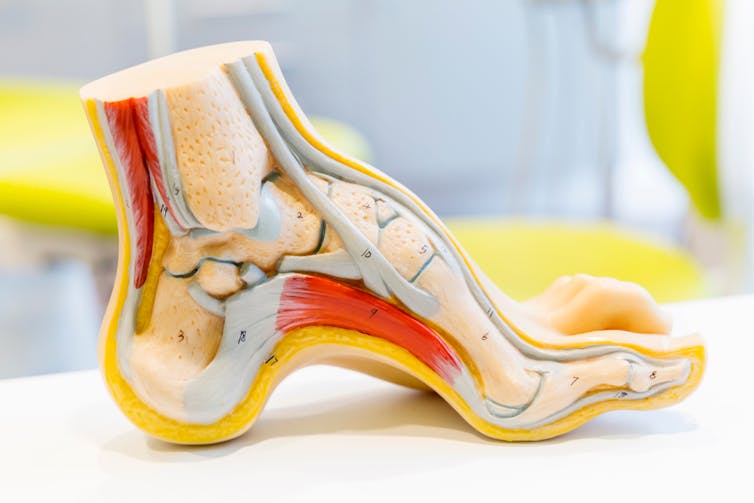It's not just athletes who get Achilles tendon pain, but exercising is the answer
- Written by Sean Docking, Post-doctoral researcher, La Trobe University
Basketball fans around the world were recently sickened by the footage of NBA star Kevin Durant’s Achilles tendon rupturing during a game.
But while many think it’s only elite athletes who suffer from Achilles tendon issues, a fifth of the over-50 population actually suffers from Achilles tendinopathy (pain). And while very few of these will be ruptures, the pain can be frustratingly persistent and limit our ability to exercise and enjoy life.
What is Achilles tendinopathy?
The Achilles tendon is one of the strongest tendons in the human body. It attaches the calf muscles to the heel bone of the foot, helping you to run fast, jump high, and change direction quickly. During these types of exercises the tendon acts like a spring that propels you forward more efficiently.
Many labels are used to describe what’s going on when the tendon is injured. People are often told their tendon is torn and may think of it as a rope hanging on by a thread. These descriptions are unhelpful and inaccurate, often leading to expensive and unnecessary treatments.
We know words are extremely powerful and influence what treatment you think you need. For example, would you do the exercises your physiotherapist gave you if you believed your tendon was hanging on by a thread? Probably not.
Our work has found a painful tendon is not like a torn rope at all. It’s more like doughnuts stacked on top of each other. Even though changes in tendon structure are seen as a “hole” in the middle of the tendon, there is still a lot of delicious doughnut (in other words healthy tendon) surrounding the damaged area. The tendon adapts by getting thicker, making it stronger and allowing you to exercise.
Critically, pain poorly reflects damage. Tendon pain is not present because the tendon is damaged, weak or hanging on by a thread. More than 30% of AFL players have a “hole” in their tendon when we scan them but are able to play at the highest level with no pain.
Read more: Health Check: why do my muscles ache the day after exercise?
Who gets it?
Achilles tendinopathy can affect athletes who participate in sports that involve running or explosive movements (Australian football, track and field). Most players do not miss competition as a result of Achilles tendon pain.
But our research found more than 20% of AFL players report that pain in their Achilles tendon significantly affects their training and performance. That’s four or five of your favourite 22 athletes playing this weekend.
 Some 20% of AFL players suffer from pain in the Achilles tendon that affects their performance.
www.shutterstock.com
Some 20% of AFL players suffer from pain in the Achilles tendon that affects their performance.
www.shutterstock.com
But most people who experience this type of pain are aged 40-64 years.
That’s because the Achilles tendon bears the brunt of activities like running, playing golf, walking the dog, and stepping off the kerb throughout life. Being overweight, having diabetes, and high cholesterol all increase the risk of developing Achilles tendon pain. Tendon pain can lead to further weight gain and a greater impact on someone’s health beyond just their ability to run and exercise.
Overcoming tendon pain
The good news is that painful Achilles tendons rarely rupture. Some 80-90% of people who rupture their tendon have never had Achilles tendon pain. Your brain is clever as it uses pain to protect your Achilles tendon by changing your behaviour. But it’s easy to become overprotective.
Completely resting the tendon, either by using crutches or a walking boot, is one thing that should be avoided. This is because of the “use it or lose it” principle. With even two weeks’ rest, your tendon and calf muscles become weaker, meaning a longer recovery time.
Just like muscles, tendons get stronger with exercise. Starting exercise that produces no or minimal pain and progressively increasing the intensity of exercise is by far the best option, based on research.
Read more: How to prevent injury from sport and exercise
In consultation with an experienced physiotherapist, this program should include strength training to help strengthen the tendon and the calf muscles. If you want to get back to running, slowly introduce exercise that requires the tendon to act like a spring, such as skipping and jumping.
It can be tempting to look for a quick fix for your pain. But interventions such as surgery or injections are often ineffective, costly, and can be harmful.
These approaches should be a last resort, and actually all still require exercise to strengthen the tendon. Unfortunately, there are no shortcuts when recovering from a tendon injury.
Unlike Achilles in Greek mythology, your Achilles tendon does not have to be a point of weakness. Consulting with an experienced physiotherapist to develop a progressive exercise program is the best protection you can have against further injury.
Authors: Sean Docking, Post-doctoral researcher, La Trobe University



